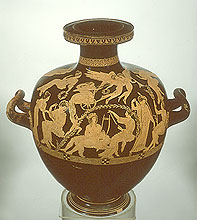It is the Meidias Painter who is the most typical representative of the new trend. His figures are graceful; they are often posed as though dancing, with expressions that range from tenderness to melancholy. The atmosphere is low-key, avoiding drama - a long way from the Classical models of the previous generation. The clothing on this painter's pots is always very carefully drawn: it has patterns of plant motifs or stars. His compositions are well-balanced: they manage to give a 'lift' to the hydria and other kinds of pot awkward to decorate.
|
 |




